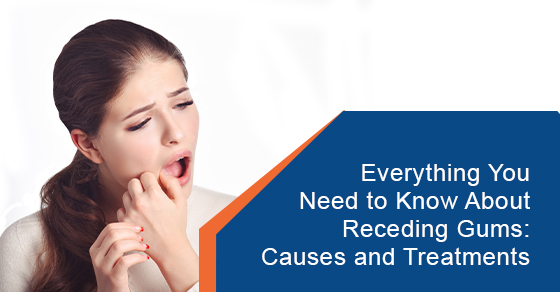Over time, you could be experiencing receding gums. Receding gums is a process where your gums begin to pull away from your tooth’s surface, causing more teeth to show and eventually exposing the roots of your teeth. This is just one expression of gum (periodontal) disease.
When gum recession occurs, it can form gaps between the teeth and gum line. This allows bacteria to build up in hard-to-reach places. If left untreated, it can cause the structure of your teeth and jaw to become extremely damaged, and can result in tooth loss in the worst-case scenario.
Receding gums are one of the most common dental problems that individuals experience as they grow older. Many people don’t know that they are suffering from gum recession because it occurs slowly over time. One of the first signs that you have receding gums is tooth sensitivity, or you might begin to notice that your teeth are looking longer than usual. A notch can be typically felt near the gum line.
Gum recession is not something that you should ignore. If you think you have receding gums, then you should make an appointment with your dentist right away. There are several treatments that can help repair your gums and prevent any further damage.
What causes receding gums?
According to the California Dental Association (CDA), three out of four adults have some type of periodontal disease, and this includes receding gums. Periodontal disease is the advanced form of gingivitis. All periodontal disease starts off as a buildup of bacteria and plaque on the teeth and gums. Over time, this plaque will cause damage. In the most advanced cases, pockets will start to form between the teeth and gums, which creates even more places for bacteria and plaque to grow.
There are many causes for a receding gum line, including:
- Brushing too hard over a long period of time
- Plaque buildup that becomes hardened into tartar
- Having bad habits such as smoking or drinking soda daily
- Hormonal changes in women
- Having a family history of gum disease
- Diabetes
- HIV
Taking certain medications can also cause something called “dry mouth”, which increases the likelihood of receding gums. When you have a dry mouth, there is not enough saliva that can help wash away bacteria and food. This means your teeth and gums are more vulnerable to getting infections.
Symptoms of receding gums can include:
- Excessive bleeding after brushing or flossing
- Inflamed gums
- Bad breath
- Painful gums
- Gums that are visibly shrinking
- Exposed tooth roots
- Loose teeth
How can gum recession be treated?
If you suffer from a mild form of gum recession and get it looked at before it becomes serious, then your dentist will be able to treat it by deep cleaning the areas that are affected. The process of deep cleaning your teeth is also known as tooth scaling and root planing. During this process, your dentist will remove the plaque and tartar that has formed on the teeth, especially below the gum line and any exposed root surfaces are smoothed to make it difficult for bacteria to get stuck in the grooves.
Your dentist might also recommend taking antibiotics in order to fully get rid of any harmful bacteria that might remain in your system.
However, if your gum recession cannot be fully treated using deep cleaning because there is excessive loss of bone and pockets have formed too deep in the gums, then you might need to undergo surgery to help repair the damage caused by gum recession.
Types of Surgery to Treat Gum Recession
These are some types of surgical procedures that are used to treat receding gums:
Regeneration
If your jaw bone has been destroyed because of gum recession, then you might need to undergo a procedure that helps you regenerate the bone and tissue. During pocket depth reduction surgery, your dentist will fold back your gum tissue to remove any bacteria. Then, a regenerative material, such as a membrane, graft tissue, or tissue-stimulating protein, is applied to help encourage your body to naturally regenerate bone and tissue. Once the regenerative tissue is in place, the gum tissues will be secured back over the root of your teeth.
Open Flap Scaling and Root Planing
The dentist will fold back the affected tissues, remove the harmful bacteria, and then secure the gum tissues back in place, which effectively eliminates the pockets or reduces their size greatly.
Soft Tissue Graft
There are many types of gum tissue graft procedures, but the most commonly used is called a connective tissue graft. During this procedure, your dentist will cut out a flap of skin from the roof of your mouth or palate, which is removed and attached to the gum tissue around the exposed roots of your teeth. Your dentist will be able to help you determine what the best type of procedure is for your situation.
How to Prevent Gum Recession
The best way to help prevent a receding gum line is to practice a good oral hygiene routine every day. You should be brushing and flossing your teeth each day and seeing your dentist at least twice per year, or as they recommend.
If you already have gum recession, then your dentist could want to see you more times each year to keep up to date with its progression. You should always be using a toothbrush that has softer bristles and brushing your teeth in small, circular motions.
For more information about gum graft surgery in Toronto, call Bloor West Smiles today at 416-766-2853 or contact us here.


Sorry, comments are closed for this post.